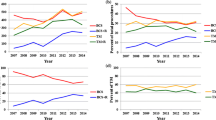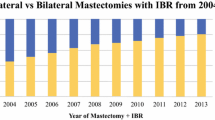Abstract
Background
In the last decade, there has been increasing use of contralateral prophylactic mastectomy (CPM) in patients with unilateral breast cancer and ductal carcinoma-in-situ (DCIS) undergoing mastectomy. Although many factors have been proposed to explain this trend, the impact of breast reconstruction on CPM has not been studied.
Methods
A retrospective review of patients with unilateral invasive breast cancer or DCIS from Surveillance, Epidemiology, and End Results registry data (2004–2008) was conducted. Characteristics of patients undergoing CPM and reconstruction were evaluated.
Results
A total of 102,674 patients diagnosed with DCIS or stage I to III infiltrating breast cancer underwent mastectomy for their primary lesion. Of these, 16,197 patients (16 %) underwent a CPM. A significantly higher proportion of women undergoing CPM had reconstruction performed (46 %) than those patients not undergoing CPM (15 %) (p < 0.001). Of the 20,760 patients (20 %) who underwent reconstruction, 7410 (36 %) had implant reconstruction, 7705 (37 %) tissue reconstruction, and 1941 (9 %) combined tissue/implant reconstruction; there were no data for 3,702 (18 %). There was an increasing trend of patients undergoing reconstruction from 2004 (n = 3390, 16.3 %) to 2008 (n = 5406, 26 %) (p < 0.001). On multivariable analysis, significant variables predicting CPM included age <45 years, stage I disease (odds ratio [OR] 1.44, 95 % confidence interval [CI] 1.35–1.54), lobular histology (OR 1.15, 95 % CI 1.11–1.20), and undergoing breast reconstruction (OR 3.58, 95 % CI 3.41–3.75).
Conclusions
Besides age, undergoing reconstructive surgery is the factor most strongly associated with CPM. This suggests that apart from risk reduction, the availability of and/or patient willingness to undergo breast reconstruction may influence the decision to undergo CPM.

Similar content being viewed by others
References
Tuttle TM, Habermann EB, Grund EH, Morris TJ, Virnig BA. Increasing use of contralateral prophylactic mastectomy for breast cancer patients: a trend toward more aggressive surgical treatment. J Clin Oncol. 2007;25:5203–9.
Tuttle TM, Jarosek S, Habermann EB, et al. Increasing rates of contralateral prophylactic mastectomy among patients with ductal carcinoma in situ. J Clin Oncol. 2009;27:1362–7.
Yao K, Stewart AK, Winchester DJ, Winchester DP. Trends in contralateral prophylactic mastectomy for unilateral cancer: a report from the National Cancer Data Base, 1998–2007. Ann Surg Oncol. 2010;17:2554–62.
King TA, Sakr R, Patil S, et al. Clinical management factors contribute to the decision for contralateral prophylactic mastectomy. J Clin Oncol. 2011;29:2158–64.
Stucky CC, Gray RJ, Wasif N, Dueck AC, Pockaj BA. Increase in contralateral prophylactic mastectomy: echoes of a bygone era? Surgical trends for unilateral breast cancer. Ann Surg Oncol. 2010;17(Suppl 3):330–7.
Arrington AK, Jarosek SL, Virnig BA, Habermann EB, Tuttle TM. Patient and surgeon characteristics associated with increased use of contralateral prophylactic mastectomy in patients with breast cancer. Ann Surg Oncol. 2009;16:2697–704.
Chung A, Huynh K, Lawrence C, Sim MS, Giuliano A. Comparison of patient characteristics and outcomes of contralateral prophylactic mastectomy and unilateral total mastectomy in breast cancer patients. Ann Surg Oncol. 2011;18:S42.
Boughey JC, Hoskin TL, Degnim AC, et al. Contralateral prophylactic mastectomy is associated with a survival advantage in high-risk women with a personal history of breast cancer. Ann Surg Oncol. 2010;17:2702–9.
Bedrosian I, Hu CY, Chang GJ. Population-based study of contralateral prophylactic mastectomy and survival outcomes of breast cancer patients. J Natl Cancer Inst. 2010;102:401–9.
Brewster AM, Bedrosian I, Parker PA, et al. Association between contralateral prophylactic mastectomy and breast cancer outcomes by hormone receptor status. Cancer. doi:10.1002/cncr.27574.
Guth U, Myrick ME, Viehl CT, Weber WP, Lardi AM, Schmid SM. Increasing rates of contralateral prophylactic mastectomy—a trend made in USA? Eur J Surg Oncol. 2012;38:296–301.
Sorbero ME, Dick AW, Beckjord EB, Ahrendt G. Diagnostic breast magnetic resonance imaging and contralateral prophylactic mastectomy. Ann Surg Oncol. 2009;16:1597–605.
Havener L. Standards for cancer registries. Volume 3. Standards for completeness, quality, analysis, and management of data. Springfield, IL: North American Association of Central Cancer Registries; 2004.
National Cancer Institute. Surveillance, Epidemiology and End Results (SEER) Program public-use data (1973–2006). National Cancer Institute, DCCPS, Surveillance Research Program, Cancer Statistics Branch; 2010. http://seer.cancer.gov/.
Rozen WM, Ashton MW, Taylor GI. Defining the role for autologous breast reconstruction after mastectomy: social and oncologic implications. Clin Breast Cancer. 2008;8:134–42.
den Heijer M, Seynaeve C, Timman R, et al. Body image and psychological distress after prophylactic mastectomy and breast reconstruction in genetically predisposed women: a prospective long-term follow-up study. Eur J Cancer. 2012;48:1263–8.
McCarthy CM, Cano SJ, Klassen AF, et al. The magnitude of effect of cosmetic breast augmentation on patient satisfaction and health-related quality of life. Plast Reconstr Surg. 2012;130:218–23.
Crosby MA, Garvey PB, Selber JC, et al. Reconstructive outcomes in patients undergoing contralateral prophylactic mastectomy. Plast Reconstr Surg. 2011;128:1025–33.
Acosta R, Smit JM, Audolfsson T, et al. A clinical review of 9 years of free perforator flap breast reconstructions: an analysis of 675 flaps and the influence of new techniques on clinical practice. J Reconstr Microsurg. 2011;27:91–8.
Zhong T, Hofer SO, McCready DR, Jacks LM, Cook FE, Baxter N. A comparison of surgical complications between immediate breast reconstruction and mastectomy: the impact on delivery of chemotherapy—an analysis of 391 procedures. Ann Surg Oncol. 2012;19:560–6.
Guerra AB, Metzinger SE, Bidros RS, et al. Bilateral breast reconstruction with the deep inferior epigastric perforator (DIEP) flap: an experience with 280 flaps. Ann Plast Surg. 2004;52:246–52.
Albornoz CR, Bach PB, Mehrara BJ, et al. A paradigm shift in U.S. breast reconstruction: increasing implant rates. Plast Reconstr Surg. 2013;131:15–23.
Cemal Y, Albornoz CR, Disa JJ, et al. A paradigm shift in U.S. breast reconstruction: part 2. The influence of changing mastectomy patterns on reconstructive rate and method. Plast Reconstr Surg. 2013;131:320e–6e.
Fischer JP, Nelson JA, Cleveland E, et al. Breast reconstruction modality outcome study: a comparison of expander/implants and free flaps in select patients. Plast Reconstr Surg. 2013;131:928–34.
Gurunluoglu R, Gurunluoglu A, Williams SA, Tebockhorst S. Current trends in breast reconstruction: survey of American Society of Plastic Surgeons, 2010. Ann Plast Surg. 2013;70:103–10.
Sisco M, Du H, Warner JP, Howard MA, Winchester DP, Yao K. Have we expanded the equitable delivery of postmastectomy breast reconstruction in the new millennium? Evidence from the National Cancer Data Base. J Am Coll Surg. 2012;215:658–66.
Disclosures
The authors declare no conflict of interest.
Author information
Authors and Affiliations
Corresponding author
Rights and permissions
About this article
Cite this article
Ashfaq, A., McGhan, L.J., Pockaj, B.A. et al. Impact of Breast Reconstruction on the Decision to Undergo Contralateral Prophylactic Mastectomy. Ann Surg Oncol 21, 2934–2940 (2014). https://doi.org/10.1245/s10434-014-3712-8
Received:
Published:
Issue Date:
DOI: https://doi.org/10.1245/s10434-014-3712-8




